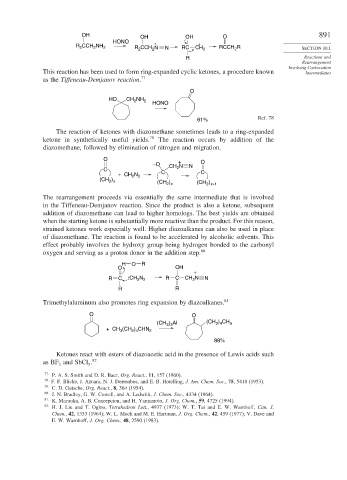Page 915 - Advanced Organic Chemistry Part B - Reactions & Synthesis
P. 915
OH OH OH O 891
HONO
+
+
R CCH NH 2 R 2 CCH N N RC CH 2 RCCH R SECTION 10.1
2
2
2
2
R Reactions and
Rearrangement
Involving Carbocation
This reaction has been used to form ring-expanded cyclic ketones, a procedure known Intermediates
as the Tiffeneau-Demjanov reaction. 77
O
HO CH NH 2
2
HONO
61% Ref. 78
The reaction of ketones with diazomethane sometimes leads to a ring-expanded
ketone in synthetically useful yields. 79 The reaction occurs by addition of the
diazomethane, followed by elimination of nitrogen and migration.
O
–O + N N O
C CH 2
+ CH N C C
2 2
(CH )
2 x
)
(CH 2 x (CH )
2 x+1
The rearrangement proceeds via essentially the same intermediate that is involved
in the Tiffeneau-Demjanov reaction. Since the product is also a ketone, subsequent
addition of diazomethane can lead to higher homologs. The best yields are obtained
when the starting ketone is substantially more reactive than the product. For this reason,
strained ketones work especially well. Higher diazoalkanes can also be used in place
of diazomethane. The reaction is found to be accelerated by alcoholic solvents. This
effect probably involves the hydroxy group being hydrogen bonded to the carbonyl
oxygen and serving as a proton donor in the addition step. 80
H O R
O OH
+
N
R C :CH 2 2 R C CH N N
2
R R
Trimethylaluminum also promotes ring expansion by diazoalkanes. 81
O O
) CH
(CH ) Al (CH 2 4 3
3 3
(CH ) CHN
+ CH 3 2 4 2
88%
Ketones react with esters of diazoacetic acid in the presence of Lewis acids such
as BF and SbCl . 82
3 5
77
P. A. S. Smith and D. R. Baer, Org. React., 11, 157 (1960).
78 F. F. Blicke, J. Azuara, N. J. Dorrenbos, and E. B. Hotelling, J. Am. Chem. Soc., 75, 5418 (1953).
79 C. D. Gutsche, Org. React., 8, 364 (1954).
80
J. N. Bradley, G. W. Cowell, and A. Ledwith, J. Chem. Soc., 4334 (1964).
81 K. Maruoka, A. B. Concepcion, and H. Yamamoto, J. Org. Chem., 59, 4725 (1994).
82
H. J. Liu and T. Ogino, Tetrahedron Lett., 4937 (1973); W. T. Tai and E. W. Warnhoff, Can. J.
Chem., 42, 1333 (1964); W. L. Mock and M. E. Hartman, J. Org. Chem., 42, 459 (1977); V. Dave and
E. W. Warnhoff, J. Org. Chem., 48, 2590 (1983).

